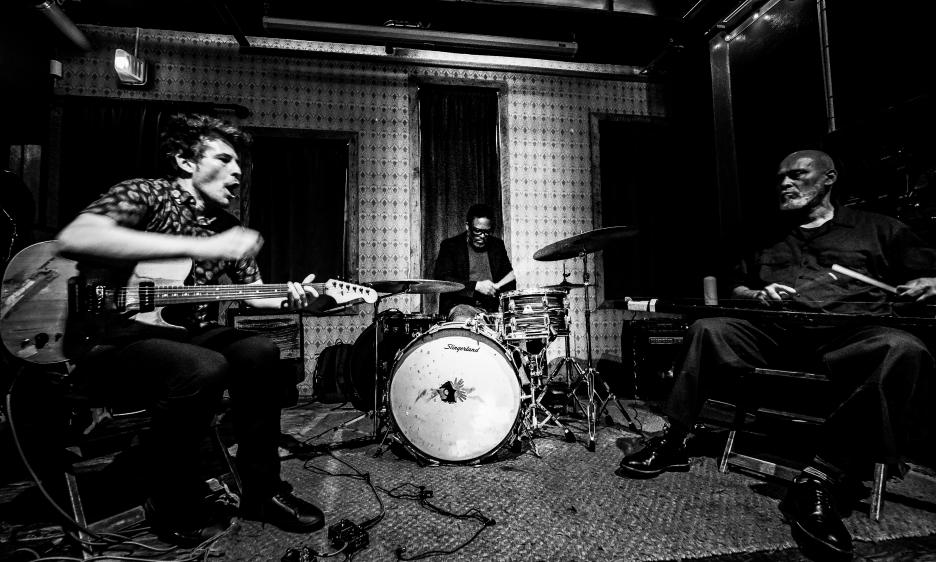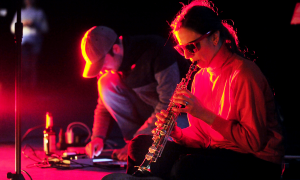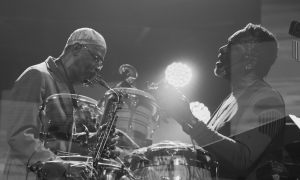Home » Jazz Articles » Festivals Talking » Moers Festival Interviews: Brandon Seabrook
Moers Festival Interviews: Brandon Seabrook

Courtesy Peter Gannushkin
He's also been something of a regular at the mighty Moers Festival, in Germany, appearing, according to his memory, in 2007, 2014 and 2015. In that last year, your scribe witnessed his gig with Eivind Opsvik's Overseas, a combo led by the Norwegian bassist, also resident in NYC. For the 2023 festival, Seabrook will appear for the first time with one of his own outfits, a somewhat supergroup trio with Gerald Cleaver (drums/electronics) and multi-instrumentalist Cooper-Moore, who concentrates on his home-made diddley-bow in this playing environment. This set is one of a handful that's been announced in extra-advance by the Moers Festival, heralding the availability of their 'early bird' tickets, a new venture for this year.
Seabrook Trio released their second album, In The Swarm, during 2022, on the Astral Spirits label. Banjo and diddley-bow strings share a certain flexibility with the bent-tone, although Cooper-Moore tends to focus on his axe's potential bass qualities, leaving Seabrook to strike out the percussive metallic arpeggios. The opening title cut does actually suggest the aural swarm-experience. Regarding the diddley-bow, it's as if Harry Partch got into the Brazilian berimbau. Cleaver has lately had a dual operation as an electronics manipulator, shaping these skills around his core beats. He, of course, dominates during "Crepuscule Of Cleaver," but Seabrook is also cloaked by thick effects, burning his guitar into a distorting haze, hailing from the edge of harmolodics. Other tracks pursue a more frazzled guitar-rockin' abstraction, overloaded with restless questioning.
The roots of this trio can be found in Black Host, a band that Cleaver led between around 2010 and '13, of which Seabrook and Cooper-Moore were also members. "That's where we all started playing together," Seabrook says, calling from Park Slope, Brooklyn. "And when that band dissolved I started this trio. We got together and it was really great. We had a 'sound' right away, the first time we started playing. It just turned into this pulsating rhythm ensemble!"
Firstly, the instrumental line-up of this crew is unusual, and then they also represent a multi-generational spread, of 77 (Cooper-Moore), 59 (Cleaver) and 47 (Seabrook). "I love that cross-pollination of generations," he enthuses. "You can learn so much from your elders, especially these guys, who've been around so long. We played for a year or two, and then made the first album. All the bass sounds are Cooper-Moore's. He can get trebly too, but for a lot of the record he's low. In the mixing process, sometimes, I brought out the low colour of the instrument, to suit the pieces. Live is different, he's all over it [tonally]."
Seabrook enjoys the post-improvisational craft of fine-tuning at the mixing desk, in the after Teo Macero manner. "I want to have mystery," he says. "What is that? What's going on? Some of the electronics are Gerald's, and sometimes I'm doing it with guitar. Our studio productions are evolving separately from our live presentation. I always sort of separate the two, because the studio to me is like another instrument. It's another place to experiment in different ways. We sculpt some of the pieces, we do some editing. I did some overdubs. We improvise, and then we take chunks of that and make pieces out of them. For the next record, I think it's maybe going to be all electronics, no real drums. I feel like each record has to evolve, to say something different."
It's been several years since your scribe caught Seabrook in action, but there was a fertile period in NYC a few years before the lockdowns arrived. Die Trommel Fatale was a very different type of band, issuing an album and playing live in 2016 and '17...
'The aura surrounding Die Trommel Fatale is one of German Expressionism, but Seabrook's music is equally concerned with hardcore thrash metal, free improvisation and electronic abstraction. These are the diverse elements, but Seabrook's highly controlled, manic concoction refines all parts into a disciplined detonation of severe collage-compactions. In other words, the pieces luxuriate in the freedoms and textures of chaos, whilst being pointedly directed and coordinated, in a fashion pioneered mainly by John Zorn. These stunning pieces are startlingly spiky, and manic almost beyond control.'
Seabrook's Die Trommel Fatale, album review, Downbeat, 2017
'Sadly, Seabrook had left his banjo at home, only bringing out his guitar for the debut of this new band, Die Trommel Fatale. The combo's scattershot assault was captured and contained, particularly as the band's two drummers either melded or staged violent exchanges from their opposite sides. This was yet another example of highly controlled composition that contained elements which sounded uncaged, anarchic and frenzied. Bass and cello were bowed in unison, brushes on skins, heading towards another introverted patch, but the next detonation was only just around the corner, Seabrook being a master of controlled demolition explosions.'
Seabrook's Die Trommel Fatale, Greenwich House Music School, NYC, June 23, 2016
Could that last gig have been the first sign of Seabrook hanging up his banjo? He describes a recent return of this tenor beast, but unless we catch him on a highly regular basis we might not have noticed. Most of Seabrook's gigs seem to find him switching between the two axes. "I retired it from my own bands, and I'm now bringing it back. I just recorded a new record with an octet, and I play more banjo and mandolin on that..."
This octet album will be released via Pyroclastic, courtesy of Kris Davis, and is set to coincide with the Moers Festival, coincidentally. "It's more compositional, with strings, percussion, electronics and contrabass clarinet. It's definitely more writing and less improvising. It's very structured."
Seabrook regularly brings his distinctive skills to ensembles with other leaders. A pair of fine examples are his work with drummer Tomas Fujiwara's Triple Double, and with Mostly Other People Do The Killing...
'Barge Music is like The Stone on water, completely dedicated to music, with no food or beverages available, just like John Zorn's Alphabet City venue. Performers usually play completely acoustically, and on this night there were only small amplifiers allowed for banjoman Brandon Seabrook and composer-frontman bassist Moppa Elliott. This was no trial, as the barge acoustics are excellent, throwing band emanations into high relief. When the MOPDTK horn front-line rocketed into fully riffing mode, their bright power ricocheted around the cosseting wooden hull.'
Seabrook with Mostly Other People Do The Killing, Barge Music, NYC, November 6, 2015
'Tomas Fujiwara's Triple Double involved twinned drums, guitars and trumpet/cornet, with Brandon Seabrook (extreme fragmentation, unlikely shapes), Ralph Alessi and Gerald Cleaver joining the leader's accustomed team with Mary Halvorson and Taylor Ho Bynum (extroverted dazzle, seated with dancing legs). A Haden and Ornette miasma-feeling sometimes grew.'
Seabrook with Triple Double, Jazzfestival Saalfelden, Jazzwise 2018
Your scribe asks Seabrook about how similar his guitar and banjo approaches might be: "They used to be separate, way back when I first started playing banjo, twenty years ago. The techniques were separate, and then they're moulded now into the same approach, although timbrally the banjo does things that the guitar can't do. It's very taut, the strings are tighter. I try to accentuate that. I don't really have 'banjo influences.'
Seabrook uses the four-string version, which is associated with Irish music and early jazz. It's the five-stringer that's more linked to bluegrass music. "It's a very sharp, percussive sound. I love drums. I almost approach the guitar like a percussion instrument. The tenor banjo has very little sustain, so you have to do the tremolo picking to make it sustain. I just gravitated towards that."
Seabrook doesn't use a massive rack of footpedals, simply sparingly using delay and reverb, opening up his sound to make it fuller, in an organic fashion. He also sometimes uses a bow on his banjo strings.
Seabrook Trio have not yet toured the US, but in 2022 they took to the Euro-road, playing ten gigs on ten consecutive nights, mixing clubs and festivals. "The live thing has also evolved in its own way. From the tour that we did last year, it's become very dynamic."
Moers Festival is a happening for May 26-29, 2023...
All vintage review excisions penned by Martin Longley
< Previous
Jay Lawrence and The Platinum Jazz Or...
Next >
The Unknown
Comments
About Brandon Seabrook
Instrument: Guitar
Related Articles | Concerts | Albums | Photos | Similar ToTags
Festivals Talking
Martin Longley
Germany
Cologne
Brandon Seabrook
Eivind Opsvik
Gerald Cleaver
Cooper-Moore
Teo Macero
john zorn
Kris Davis
Tomas Fujiwara
Moppa Elliott
Ralph Alessi
Mary Halvorson
Taylor Ho Bynum
For the Love of Jazz
 All About Jazz has been a pillar of jazz since 1995, championing it as an art form and, more importantly, supporting the musicians who create it. Our enduring commitment has made "AAJ" one of the most culturally important websites of its kind, read by hundreds of thousands of fans, musicians and industry figures every month.
All About Jazz has been a pillar of jazz since 1995, championing it as an art form and, more importantly, supporting the musicians who create it. Our enduring commitment has made "AAJ" one of the most culturally important websites of its kind, read by hundreds of thousands of fans, musicians and industry figures every month.
























